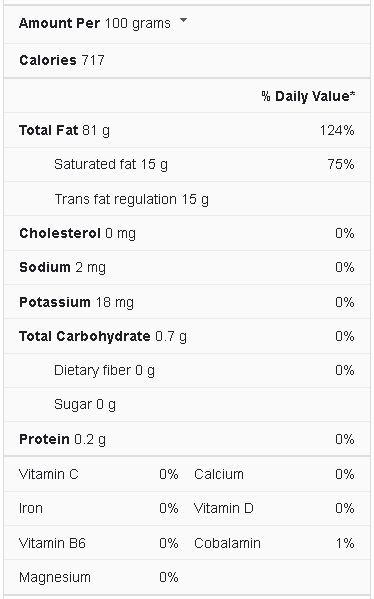Margarine is made by mixing several different vegetable oils, and corn and soybean oil are two of the most frequent oils used in margarine. The oil is first hydrogenated, which is a chemical procedure that involves forcing hydrogen gas into unsaturated fatty acids to partially saturated the oil.
Most margarine is about 80% fat, and saturated and unsaturated fats combine to form this fat. Depending on the type of vegetable utilized, the saturated fat content of margarine can range from 7 to 86 percent. Saturated fat levels in coconut and palm kernel oil are higher than canola or sunflower oil. Vitamin A, vitamin D, vitamin E, and vitamin K are all found in margarine’s fat.
Alpha-linolenic acid, or ALA, is an omega-3 fatty acid found in margarine. Omega 3 fatty acids have been demonstrated to decrease inflammation and lower total cholesterol and triglycerides. Flaxseed oil or fish oil are added to some commercial margarine types to boost the amount of beneficial omega-3 fatty acids. Plant sterol is added to the oils in many commercial margarine brands, and cholesterol levels have been reduced by plant sterol.
Margarine Nutrition Facts
What is Exactly Margarine?
Margarine is a flavoring, baking, and cooking spread, and it’s most commonly used as a butter substitute. Although margarine was initially derived from animal fats, it is now mostly made from vegetable oil. The name oleomargarine comes from the Latin word oleum (olive oil) and the Greek word margarite (margarine) (pearl indicating luster). Later, the name was abbreviated to margarine.
Margarine is a stable solid version of a water-in-fat emulsion, with tiny droplets of water scattered equally throughout the fat phase. Modern margarine is manufactured from more intensive processing of refined vegetable oil and water than butter, made from the butterfat of milk. To be labeled as margarine in various US jurisdictions, it must have a minimum fat content of 80% (with a maximum of 16% water).
What are the Health Benefits of Margarine?
The health benefits of margarine depend on what kind of vegetable oils it contains and how it is processed.
- Polyunsaturated fat is abundant in most forms of margarine, and the exact amount depends on which vegetable oils were utilized in the manufacturing process. For example, margarine made from soybean oil may contain about 20% polyunsaturated fat.
- Polyunsaturated fat is generally thought to be good for you. Compared to saturated fat, it may even be beneficial to heart health.
- Replacing saturated fat with polyunsaturated fat, for example, has been linked to a 17 percent lower risk of heart disease but has no meaningful influence on the chance of mortality from heart disease.
- Phytosterols and stanols are added to some portions of margarine, and these chemicals are also abundant in vegetable oils. In the short term, phytosterol-enriched portions of margarine lower total and “bad” LDL cholesterol, but they may also lower “good” HDL cholesterol. However, most studies haven’t shown a link between total phytosterol intake and the risk of heart disease.
Conagra Fleischmanns Solid Margarine Unsalted
- Refrigerated items are perishable and tend to have short shelf lives – some of these can be as little as two weeks from the date of receipt – if you are ordering a large quantity, or are otherwise concerned about expiration dates, consider a frozen product.
- Ships refrigerated can not be canceled after being processed.
What’s Healthier Butter or Margarine?
When it comes to heart health, margarine usually beats butter.
Margarine is manufactured from vegetable oils; therefore, it contains polyunsaturated and monounsaturated fats, unsaturated “healthy” fats. When these fats are swapped for saturated fat, they help lower low-density lipoprotein (LDL) or “bad” cholesterol.
Because butter is manufactured from animal fat, it has a higher saturated fat content. However, not all margarine is made equal, with some containing trans fat. The more solid the margarine, the more trans fat it generally contains. As a result, stick portions of margarine typically contain more trans fat than tub portions of margarine.
Like saturated fat, trans fat raises blood cholesterol levels and increases the risk of heart disease. Furthermore, trans fat reduces high-density lipoprotein (HDL), or “good” cholesterol. So, instead of using a stick, use soft or liquid margarine.
Look for a spread with no trans fats and as little saturated fat as possible. When comparing spreads, read the Nutrition Facts panel and look at the saturated and trans fat grams. To cut calories, reduce the amount you use.
Healthier Alternatives of Margarine
Switching from butter to margarine may help you lose a few calories, but it’s unlikely that you’ll notice much of a change. There are alternatives to those creamy yellow spreads, even though they are a widely accepted staple in American food culture. Perhaps most importantly, they are healthier alternatives.
The next time you grab that little yellow stick, try substituting olive oil or another plant- or nut-based oils and spreads. Instead of butter or margarine, try a drizzle of olive oil on your bread or baked potato. Nonetheless, if you follow the all-things-in-moderation method, margarine can have a place in your diet.
Can You Use Margarine in Baking?
Low-fat/light margarine contains a lot of water, making it inappropriate for cooking and baking – read the label! Stick margarine, also known as a block or hard margarine, has a buttery texture that makes it a better baking and cooking substitute than tub margarine.
When it comes to baking, butter always wins out over margarine. Cakes, cookies, and pastries with unsalted butter have a richer flavor. Because margarine includes more water and less fat, it may cause thin cookies to spread out when baking (and may burn).
What are the Risks of Eating Margarine?
Although margarine may include certain heart-healthy elements, it is frequently high in trans fat and linked to an increased risk of heart disease and other chronic illnesses.
It May Be High in Trans Fats
Vegetable oils, unlike butter, do not solidify at room temperature. To make them firm enough for use in margarine, food scientists utilize a procedure known as hydrogenation to modify their structure chemically. The oils are subjected to high heat, high pressure, hydrogen gas, and a metal catalyst in this process. Hydrogenation converts some unsaturated fat to saturated fat, which is solid at room temperature and extends the product’s shelf life. Regrettably, trans fat is generated as an afterthought. An elevated risk of chronic disease has been related to a high diet of industrial trans fats.
May Be High in Omega-6 Fat
Polyunsaturated fats come in a variety of forms. They are frequently classified according to their chemical structure. Omega-3 and omega-6 lipids are two of the most frequent.Omega-3 fatty acids are anti-inflammatory, which means they fight inflammation. Consuming too much omega-6 fat, on the other hand, may increase chronic inflammation. The ideal omega-6 to omega-3 ratio, based on historical diets, is thought to be around 1:1. If this ratio has any health implications, today’s population consumes far too much omega-6 fat. In fact, in wealthy countries, the ratio is reported to be as high as 20:1. In observational studies, high omega-6 fat intake has been related to an increased risk of obesity and chronic illnesses like heart disease and inflammatory bowel disease.
Conclusion
While margarine is not dairy-based, many types contain trace amounts of animal products, usually in the form of whey or lactose. If you have a dairy allergy or are a strict vegan, you will want to use only those types of margarine that are free of even small amounts of dairy. Butter and margarine have a similar appearance and are used in the kitchen for the same reason. Their nutritional profiles, however, are different. While butter has a lot of saturated fat, margarine contains a lot of unsaturated fat and even trans fat.
Saturated fat’s health effects are debatable, and its role in heart disease has been reduced in recent years. Trans fats, which are included in some portions of margarine, boost the risk of chronic disease. As a result, trans-fat-free portions of margarine are becoming more popular. If you prefer margarine to butter, look for trans-fat-free varieties and items manufactured with healthy oils like olive oil. If you like butter, look for items prepared from grass-fed cow’s milk. There is no clear winner in the end, although I like less processed items, such as butter. Consume these goods in moderation, whatever you choose.






